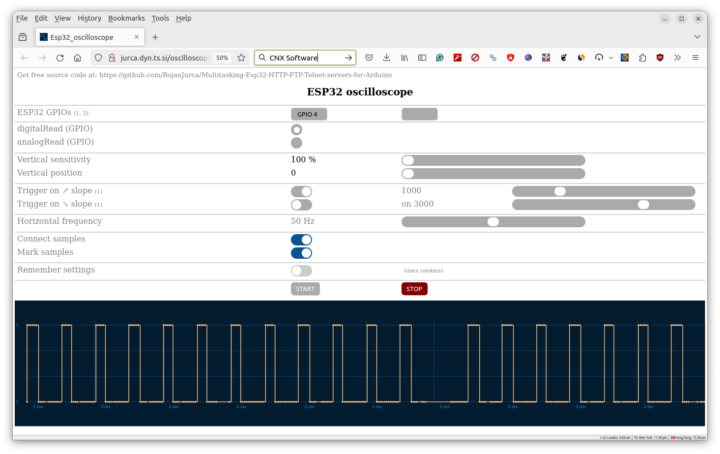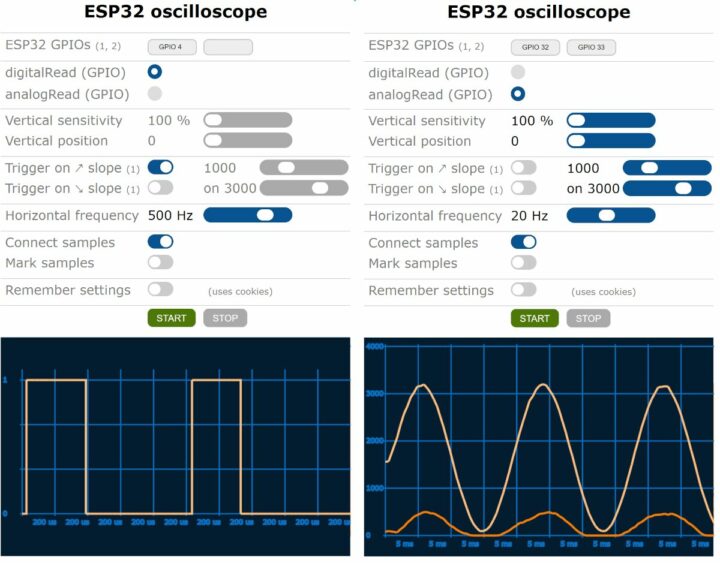Bojan Jurca’s “Esp32_oscilloscope” is an open-source Arduino sketch that can transform an ESP32 board into a web-based oscilloscope that works over WiFi.
We had also written about the Scoppy project to turn the Raspberry Pi Pico W into a 2-channel oscilloscope, but there’s no reason the more powerful ESP32-series microcontroller could not be used for the same purpose, and Bojan’s Esp32_oscilloscope project does just that and works with ESP32, ESP32-S2, ESP32-S3 and ESP32-C3 boards using the I2S interface for fast data sampling.
The project was initially designed to demonstrate the multitasking abilities of the ESP32 microcontroller with Arduino, but this evolved into an ESP32 oscilloscope firmware. It works both with output/PWM and input signals, digital (0 or 1) and analog (0 to 4095) signals, and the web interface shows up to 736 samples per screen although the sampling rate may not be completely constant all the time.
To install it on your board, you’ll need to load the project in the Arduino IDE and set your router credentials and the hostname:
|
1 2 3 4 5 6 |
// if these #definitions are missing STAtion will not be set up #define DEFAULT_STA_SSID "YOUR_STA_SSID" // <- replace with your information #define DEFAULT_STA_PASSWORD "YOUR_STA_PASSWORD" // <- replace with your information // define the name Esp32 will use as its host name #define HOSTNAME "MyEsp32Oscilloscope" // <- replace with your information, max 32 bytes |
The program relies on the FAT file system, so you’ll need to select one of the FATFS partition schemas in Tools->Partition scheme-> ... unless the ESP32 board does not have external flash in which case you’d need to comment out the
|
1 |
#define FILE_SYSTEM FILE_SYSTEM_FAT |
…in order for the firmware to use progmem to store the oscilloscope.html file. Now you can build the program and flash it to your board. You’ll also need to upload a few files to the /var/www/html directory (android-192-osc.png, apple-180-osc.png, oscilloscope.html) over FTP, and you should be able to access the oscilloscope with “http://your-esp32-ip/oscilloscope.html” or “http://esp32-hostname/oscilloscope.html” URL from your web browser.
 If you are short on time and/or don’t happen to have an ESP32 board on hand, Bojan is also running a demo at http://jurca.dyn.ts.si/oscilloscope.html as shown in the screenshot above. The full details for the Esp32_Oscilloscope project can be found on GitHub. It’s not the first time we cover a project that shows the status of ESP32 GPIO pins in a web browser, as GPIOViewer does just that but serves a different use case.
If you are short on time and/or don’t happen to have an ESP32 board on hand, Bojan is also running a demo at http://jurca.dyn.ts.si/oscilloscope.html as shown in the screenshot above. The full details for the Esp32_Oscilloscope project can be found on GitHub. It’s not the first time we cover a project that shows the status of ESP32 GPIO pins in a web browser, as GPIOViewer does just that but serves a different use case.

Jean-Luc started CNX Software in 2010 as a part-time endeavor, before quitting his job as a software engineering manager, and starting to write daily news, and reviews full time later in 2011.
Support CNX Software! Donate via cryptocurrencies, become a Patron on Patreon, or purchase goods on Amazon or Aliexpress. We also use affiliate links in articles to earn commissions if you make a purchase after clicking on those links.





